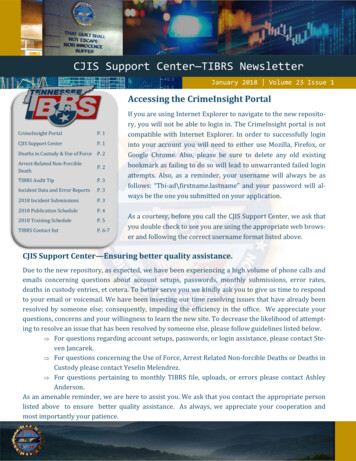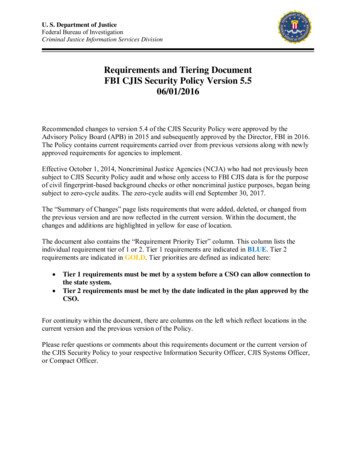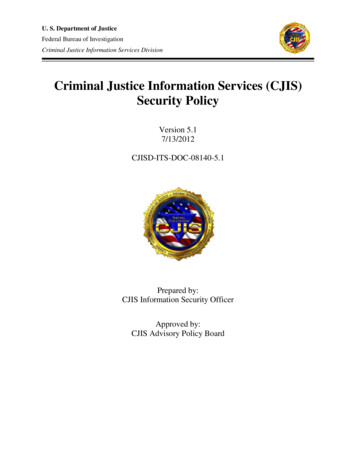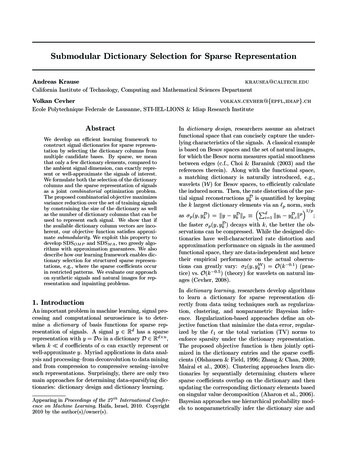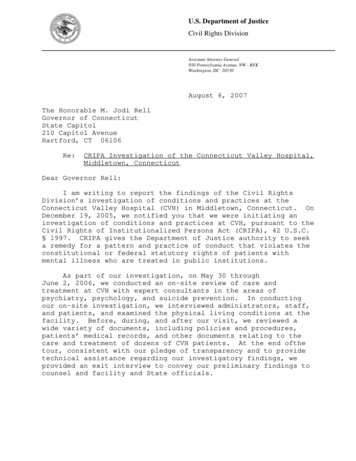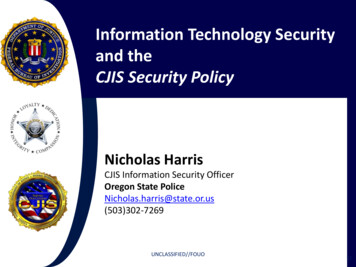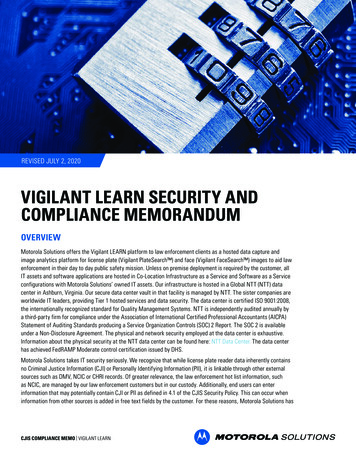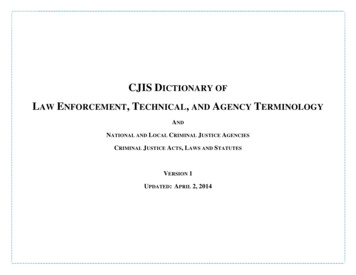
Transcription
CJIS DICTIONARY OFLAW ENFORCEMENT, TECHNICAL, AND AGENCY TERMINOLOGYANDNATIONAL AND LOCAL CRIMINAL JUSTICE AGENCIESCRIMINAL JUSTICE ACTS, LAWS AND STATUTESVERSION 1UPDATED: APRIL 2, 2014
ContentsCriminal Justice Dictionary . 3Criminal Justice Agencies and Departments. 33National Agencies . 40Technical Definitions . 41Connecticut Statutes. 46CGS §54-142s (CISS) . 46CGS § 54-142g (Criminal Justice Agency) . 48CGS §54-142q (CJIS Governing Board) . 49Authorized Sentences:. 51Probation and Conditional Discharge . 52Laws and Acts . 55Related Documentation Links:. 572 Page
Criminal Justice DictionaryTo help clarify terminology when working with stakeholders and CJIS employees, the following living list is being provided and will be continuallyupdated. So far, this table includes some terms that might be incorrectly used interchangeably while in discussions about CISS.TermAbscondDefinitionHe was put into jail but absconded within a fewdays.NotesReference:SR?See also:Probation AbsconderAdministration ofCriminal JusticeThe Administration of Criminal Justice is thedetection, apprehension, detention, pre-trial release,post-trial release, prosecution, adjudication,correctional supervision, or rehabilitation of accusedpersons or criminal offenders. It also includescriminal identification activities; the collection,storage, and dissemination of criminal history recordinformation; and criminal justice employment. Inaddition, administration of criminal justice includes“crime prevention programs” to the extent that accessto the criminal history record information is limited tolaw enforcement agencies for law enforcementprograms (e.g. record checks of individuals whoparticipate in Neighborhood Watch or “safe house”programs) and the result of such checks will not bedisseminated outside the law enforcement agencyAffiantAn affiant is any person having the intellectualcapacity to take an oath or make an affirmation andwho has knowledge of the facts that are in dispute tomake an affidavit. There is no age requirement for anaffiant. As long as a person is old enough tounderstand the facts and the significance of the oathor affirmation he or she makes, the affidavit is valid.A criminal conviction does not make a personincapable of making an affidavit, but an adjudicationof incompetency does.The two detectives completed the searchwarrant affidavit and swore to its contents as theaffiants of the search warrant before the judge.Reference:Someone familiar with the matters in question maymake an affidavit on behalf of another, but that3 PageCriminal Justice DictionaryAbscond is generally used to describe someonerunning from law or capture.Example
TermDefinitionExampleNotesperson's authority to do so must be clear. A guardianmay make an affidavit for a minor or insane personincapable of doing so. An attorney may make anaffidavit for a client if it is impossible for the client todo so. When necessary to the performance of duties,a personal representative, agent, or corporate officeror partner may execute an affidavit that indicates thecapacity in which the affiant acts.A court cannot force a person to make an affidavit,since, by definition, an affidavit is a voluntarystatement.AffidavitAn affidavit is a written statement of facts voluntarilymade by an affiant under an oath or affirmationadministered by a person authorized to do so by law.The officer completed the affidavit for an arrestwarrant.See also:An affidavit is voluntarily made without any crossexamination of the affiant and, therefore, is not thesame as a deposition, a record of an examination ofa witness or a party made either voluntarily orpursuant to a subpoena, as if the party weretestifying in court under cross-examination.AFISAlford PleaAutomated Fingerprint Identification System(AFIS) is the process of automatically matching oneor many unknown fingerprints against a database ofknown and unknown prints. Automated fingerprintidentification systems are primarily used by lawenforcement agencies for criminal identificationinitiatives, the most important of which includeidentifying a person suspected of committing a crimeor linking a suspect to other unsolved crimes.Reference:Custody affidavitThe subject was fingerprinted on a LiveScanstation and his fingerprints were submitted toAFIS. The officer decided that the subject hadgiven him a false name when AFIS determinedthe fingerprints belonged John Smith not JoeMartin.Reference:See also:CogentLiveScanAn Alford plea, also called a Kennedy plea in West[1]Virginia, an Alford guilty plea, andthe Alford doctrine is a guilty plea in criminalwhereby a defendant in a criminal case does notadmit the criminal act and asserts innocence. Inentering an Alford plea, the defendant admits that theevidence that the prosecution has would be likely topersuade a judge or jury to find the defendant guiltybeyond a reasonable doubt. .4 Page
TermDefinitionArsonArson is when a person starts a fire with intent todestroy or damage a building.ArrestAn arrest is when someone is taken into custody inviolation of the law. The person is formally seized:you don’t have to say or do anything to arrestsomeone. An arrest is not the same thing as beingdetained.ExampleNotesThe subject was taken into custody and placedunder arrest.Reference:The officer submitted an arrest warrant to court,which was approved by the prosecutor and ajudge. Upon receiving the arrest warrant, theofficer located and arrested the subject of thewarrant.Reference:Two types of arrest documents: Arrest WarrantUniform Arrest ReportsSummonsAn arrest warrant is a warrant issued by a judge onbehalf of the state, which authorizes the arrest anddetention of an individual, or the search and seizureof an individual's property.See also:WarrantBench WarrantExecution WarrantSearch WarrantAssaultA person by means of a deadly weapon ordangerous instrument causes serious physical injuryto another person.Assault WeaponAn Assault Weapon is any selective-fire firearmcapable of fully automatic, semiautomatic or burst fireat the option of the user or any of the specifiedsemiautomatic firearms name in §53-202a.Bench WarrantA bench warrant is a set of court papers issued bythe judge, "from the bench," for the arrest of aperson.See also:WarrantArrest WarrantExecution WarrantSearch WarrantBondA bond, also called bail, is money or property givento the court for the temporary release of a defendant,to ensure that the defendant will return to court.There are two kinds of bonds:Non-financial bonds:Reference:5 Page
TermDefinitionExampleNotesa) Non-surety bond where the defendant'ssignature alone guarantees the amount of bond andthe defendant is not required to post any property orretain the services of a professional bail bondspersonas collateral.b) Promise to appear.Surety bond: The court requires cash, real estate ora professional bail bond person’s signature ascollateral before releasing the defendant back intothe community. (The court may allow the defendantto post ten percent of the bond in cash to secure hisor her release.)BookingA booking is the procedure by which law enforcementofficials record facts about the arrest of and chargesagainst a suspect such as the crime for which thearrest was made, together with informationconcerning the identification of the suspect and otherpertinent facts.The subject was transported to policeheadquarters where he was “booked.”Reference:This information is written down on the police blotterin the police station. The process of booking mayalso include photographing and fingerprinting.BurglaryThe felony of breaking into and entering the house ofanother at night with intent to steal, extended bystatute to cover the breaking into and entering of anyof various buildings, by night or day.Case ManagementInformationSystem (CMIS)Case NotesThe Judicial Branch's Case Management InformationSystem (CMIS) contains case information.Case/IncidentHistoryCase or Incident History is all relevant informationgathered about an individual, organization, incident,or combination thereof, arranged so as to serve asan organized record to provide analytic value for acriminal justice organization. In regards to CJI, it isthe information about the history of criminal incidents.ChildA child means any person under eighteen years ofage who has not been legally emancipated, exceptCase Notes is the parole agent and case historyrecords and notes management system6 Page
TermDefinitionExampleNotesthat for the purposes of delinquency matters andproceedings, “child” means any person under ageseventeen years of age who has not been legallyemancipated, or seventeen years of age or olderwho, prior to attaining seventeen years of age,committed a delinquent act or, subsequent toattaining seventeen years of age, violates any orderof the Superior Court or any condition of probationordered by the Superior Court with respect to adelinquency proceeding, or willfully fails to appear inresponse to a summons under section 46b-133 orany other court hearing in a delinquency proceedingof which the child had notice, and for purposes offamily with service needs matters and proceedings,child means a person under seventeen years of age.CISS UserA CISS User is an individual in a CJIS agency thathas been approved to access CISS and its functionsand its reports. The CISS user has a valid User ID,password, access rights, claims and provisionedfunctions to access the system.Cogent3M Cogent's system uses LiveScan software tocapture finger and palm prints electronically, encodeprints into searchable files, and, using the AutomatedFingerprint/Palmprint Identification System (AFIS),accurately compare a set of fingerprints/palm printsto a database containing potentially millions of printsin seconds.Computer AidedDispatch (CAD)Reference:See also:LiveScanAFISComputer-assisted dispatch, also called ComputerAided Dispatch (CAD), is a method of dispatchingtaxicabs, couriers, field service technicians, masstransit vehicles or emergency services assisted bycomputer. It can either be used to send messages tothe dispatchee via a mobile data terminal (MDT)and/or used to store and retrieve data (i.e. radio logs,field interviews, client information, schedules, etc.). Adispatcher may announce the call details to field unitsover a two-way radio. Some systems communicateusing a two-way radio system's selective callingfeatures. CAD systems may send text messages with7 Page
TermDefinitionExampleNotescall-for-service details to alphanumeric pagers orwireless telephony text services like SMS. Thecentral idea is that persons in a dispatch center areable to easily view and understand the status of allunits being dispatched. CAD provides displays andtools so that the dispatcher has an opportunity tohandle calls-for-service as efficiently as possible.CAD typically consists of a suite of softwarepackages used to initiate public safety calls forservice, dispatch, and maintain the status ofresponding resources in the field. It is generally usedby emergency communications dispatchers, calltakers, and 911 operators in centralized, publicsafety call centers, as well as by field personnelutilizing mobile data terminals (MDTs) or mobile datacomputers (MDCs).CAD systems consist of several modules that provideservices at multiple levels in a dispatch center and inthe field of public safety. These services include callinput, call dispatching, call status maintenance, eventnotes, field unit status and tracking, and callresolution and disposition. CAD systems also includeinterfaces that permit the software to provide servicesto dispatchers, call takers, and field personnel withrespect to control and use of analog radio andtelephone equipment, as well as rent sentences are sentences in which theprison time for more than one crime is served at thesame time and only lasts as long as the longest term.See also: Authorized SentencesConditionalDischargeConditional discharge is a disposition, in criminalcases, where the defendant must satisfy certaincourt-ordered conditions instead of a prison term.Reference:See also: Probation and Conditional DischargeConfidentialityConfidentiality is the concept of ensuring that8 Page
TermDefinitionExampleNotesinformation is observable only to those who havebeen granted authorization to do so.ConnecticutInformationSharing System(CISS)ConnecticutIntegrated Vehicleand LicensingSystem (CIVLS)ConsecutiveSentencesSee CGS §54-142s.The Connecticut Integrated Vehicle and LicensingSystem (CIVLS) is a Department of Motor Vehicles(DMV) application. The application will: allow more transactions online (includingmotor vehicle registration renewals); provide interactive manual for completingforms online (“lead-through processing”); use barcode readers to speed data entry andreduce errors; give DMV database access to automobiledealerships so that dealers may register carsin real time, as if the care were beingregistered by agency personnel, significantlyreducing customer wait times; and eliminate the need for vehicle registrationstickers.Consecutive sentences are sentences in which theterms for several crimes are served one after anotherSee also: Authorized SentencesCriminal HistoryRecordInformation (CHRI)Criminal History Record Information (CHRI),sometimes informally referred to as “restricted data,”is a subset of the CJI. Due to its comparativelysensitive nature, additional controls are required forthe access, use and dissemination of CHRI. Inaddition to the dissemination restrictions outlinedbelow, Title 28, Part 20, Code of Federal Regulations(CFR), defines CHRI and provides the regulatoryguidance for dissemination of CHRI. While the CJISSecurity Policy attempts to be architecturallyindependent, the III and NCIC are specificallyidentified in Title 28, Part 20, CFR and the NCIC9 Page
TermDefinitionExampleNotesOperating Manual, as associated with CHRI.Criminal JusticeInformation (CJI)Criminal Justice Information is the term to refer to allof the FBI CJIS provided data necessary for lawenforcement and civil agencies to perform theirmissions including, but not limited to biometric,identity history, biographic, property, andcase/incident history data.Criminal MotorVehicle System(CRMVS)The Criminal Motor Vehicle System (CRMVS) is astatewide Judicial Branch Criminal and Motor VehicleCourt Case Management application and serves asan integrated data source system for multiple agencysystems. CRMVS contains criminal arrest,continuance and disposition data that has beenentered into the system from the Uniform ArrestReports (UARs). Certain fields are required to beentered into the data input screens (defendant,arrest or charge). A section of the CRMVS Manualfor entry of UAR data shows the variousfields entered into CRMVS. Not all informationcontained on the UARs is entered into CRMVS andonly information available can be entered.CriminalNegligenceA person acts with "criminal negligence" withrespect to a result or to a circumstance described bya statute defining an offense when he fails toperceive a substantial and unjustifiable risk that suchresult will occur or that such circumstance exists. Therisk must be of such nature and degree that thefailure to perceive it constitutes a gross deviationfrom the standard of care that a reasonable personwould observe in the situation.CT ImpairedDriver RecordsInformationSystem (CIDRIS)The Connecticut Impaired Driver Records InformationSystem (CIDRIS) provides automation and electronicexchange of Operating Under the Influence (OUI)arrest data and documents between the Departmentof Emergency Services and Public Protection(DESPP), the Department of Motor Vehicles (DMV),the Division of Criminal Justice (DCJ), and the10 P a g e
TermDefinitionExampleNotesSuperior Court Operations Division (SCO) (Judicial).CT On-Line COLLECT)CT On-Line Law Enforcement CommunicationsTeleprocessing Network (COLLECT) is the statewidecriminal justice system, dedicated to the lawenforcement and criminal justice agencies in theState of Connecticut, to access online State andFederal law enforcement resources. Access toCOLLECT is granted only to law enforcement andcriminal justice agencies. The COLLECT systemservices over 180 local, state and federal agencies.CustodyCustody is when someone is under arrest and theperson is not free to leave. The person is in custodyregardless of whether they are handcuffed or not. Aperson who is issued a summons in the field is alsounder arrest and is in custody.Reference:Custody AffidavitCustody affidavit is a sworn statement containingfacts about a child involved in a case, including fullname of the child, date of birth, current and pastresidences and other information as may be requiredby law.Reference:DangerousinstrumentDangerous instrument means any instrument, articleor substance which, under the circumstances inwhich it is used or attempted or threatened to beused, is capable of causing death or serious physicalinjury, and includes a "vehicle" as that term is definedin this section and includes a dog that has beencommanded to attack, except a dog owned by a lawenforcement agency of the state or any politicalsubdivision thereof or of the federal governmentwhen such dog is in the performance of its dutiesunder the direct supervision, care and control of anassigned law enforcement officer.Deadly physicalforceDeadly physical force means physical force whichcan be reasonably expected to cause death orserious physical injury.Deadly weaponDeadly weapon means any weapon, whether loadedor unloaded, from which a shot may be discharged,or a switchblade knife, gravity knife, billy, blackjack,See also:Affidavit11 P a g e
TermDefinitionExampleNotesbludgeon, or metal knuckles. The definition of"deadly weapon" in this subdivision shall be deemednot to apply to section 29-38 or 53-206DetainIn CT, detention is defined as: Investigativedetention: Detention that is not overly intrusive. Itcan be characterized as a minimal intrusion designedto quickly dispel or confirm the suspicions whichjustified the initial stop. When the detention hasexceeded the permissible boundaries, the detentionbecomes an arrest requiring probable cause.DismissalA dismissal is a judge's decision to end the case.DispositionThe officer smelled the odor of marijuana in thesubject’s car. The subject was detained while apolice K-9 searched the interior of the vehicle forcontraband. The subject was not under arrest.Reference:A disposition is the court's final determination of alawsuit or criminal charge.The subject pleaded guilty and received twoyears’ probation.Reference:DocketA docket is a list of cases scheduled to be heard incourt on a specific day or week.The subject’s arrest was added to the docket sothat he could be arraigned.Reference:Docket NumberA docket number is a unique number the court clerkassigns to a case. It must be used on all futurepapers filed in the court case.Reference:Each docket number starts with two letters that tellthe type of case. CI criminal infraction; CR criminal case; CV civil case; FA family case; MI motor vehicle infraction; MV motor vehicle case; SC small claims.Electronic defenseweaponAn electronic defense weapon is a weapon which byelectronic impulse or current is capable ofimmobilizing a person temporarily, but is not capableof inflicting death or serious physical injury, includinga stun gun or other conductive energy device.Employee of anemergencymedical serviceorganizationAn employee of an emergency medical serviceorganization is an ambulance driver, emergencymedical technician or paramedic as defined insection 19a-175.ErasureAn erasure is the obliteration of a writing; it willrender it void or not under the same circumstancesas an interlineation. Erasures and interlineations(writing between the lines of a document, usually to12 P a g e
TermDefinitionExampleNotesadd something that was omitted or thought of later)are presumed to have been made after the executionof a deed, unless the contrary be provedEscapeEscape is to get away from a place that you are notallowed to leave.Execution WarrantAn execution warrant (or death warrant or blackwarrant) is a writ which authorizes the execution onan individual. An execution warrant is not to beconfused with a “license to kill,” which operates likean arrest warrant but with deadly force instead ofarrest as the end goal.Failure to Appear(FTA)Failure to Appear (FTA) is the legal term for thefailure of a defendant or respondent to appear at (orwithin) the stated time before a tribunal as directed ina summons. Where the conduct alleged in thesummons or complaint is an infraction or summaryoffence, failure to appear is a crime for which abench-warrant can be issued if the defendantpromised to appear.FeloniesFelonies are the most serious type of criminaloffense. Felonies typically involve serious physicalharm (or threat of harm) to victims, but felonyoffenses also include white collar crimes and fraudschemes. Offenses that otherwise are misdemeanorscan be elevated to felonies for second-timeoffenders.Punishment for felonies ranges from imprisonment inprison for one year to life in prison without parole,and felonies like murder may even be punished byimposition of the death penalty.Connecticut subdivides felonies by class. Somecrimes have a mandatory minimum sentence or aminimum sentence higher than the minimum termspecified in the table. Repeated or persistentoffenses may result in a higher maximum thanspecified here.In 1999, Leslie Dale Martin and three otherinmates on Louisiana’s death row escaped fromtheir cells at the Louisiana State Penitentiary.Reference:Reference:See Also:WarrantSearch WarrantExample 1. Randy is convicted of assault with adeadly weapon even though the bottle that hethrew at another patron in a tavern missed itsintended target. Randy will probably beconvicted of a felony because even though hefailed to injure the intended victim, his behaviorwas intended to (and did) create a risk of seriousphysical injury.Reference:Example 2. Lenora was convicted of shopliftingfifteen months before she is charged withanother shoplifting offense. State law may allow(but not require) the prosecutor to chargeLenora with felony shoplifting.13 P a g e
TermDefinitionExampleNotesFelonyClassificationof crimeImprisonment FineCapitalExecution orlifeClass A(murder)25 to 60 years Up to 20,000Class A10 to 25 years Up to 20,000Class B1 to 20 yearsUp to 15,000Class C1 to 10 yearsUp to 10,000Class D1 to 5 yearsUp to 5,000-UnclassifiedCapitolFirearmA firearm is any sawed-off shotgun, machine gun,rifle, shotgun, pistol, revolver or other weapon,whether loaded or unloaded from which a shot maybe discharged.FirefighterA firefighter is any agent of a municipality whose dutyit is to protect life and property therein as a memberof a duly constituted fire department whetherprofessional or volunteer.Global FederatedIdentity andPrivilegeManagement(GFIPM):Hot PursuitGlobal Federated Identity and Privilege Management(GFIPM) is a group of guidelines and standards forestablishing, implementing, and governing federatedidentity management approaches.Hot pursuit is if a criminal flees the scene of a crimeand the police officer follows him, the officer has theright to enter a property in which the criminal hassought shelter.Reference:See also:Warrant14 P a g e
TermIAFISDefinitionThe Integrated Automated Fingerprint IdentificationSystem (IAFIS) is a national automated fingerprintidentification and criminal history system maintainedby the Federal Bureau of Investigation (FBI). IAFISprovides automated fingerprint search capabilities,latent searching capability, electronic image storage,and electronic exchange of fingerprints andresponses.ExampleEmployment background checks and legitimatefirearms purchases cause citizens to bepermanently recorded in the system.NotesReference:See also:AFISIAFIS is the largest biometric database in the world,housing the fingerprints and criminal histories of 70million subjects in the criminal master file, 31 millioncivil prints and fingerprints from 73,000 known andsuspected terrorists processed by the U.S. or byinternational law enforcement agencies.IncarcerationIncarceration is confinement to a state correctionalinstitute or prison.IndeterminateSentencesIndeterminate sentences are sentences in which theactual release date is not set and will be based onreview of prison conduct.The subject was found guilty and sentenced totwelve months in prison.See also: Authorized EPD)To begin exchanging information, informationexchange partners must first develop a dataexchange. In NIEM, a “data exchange” is also knownas an Information Exchange Package (IEP), adescription of specific information exchangedbetween a sender and a receiver. The IEP is usuallycoupled with additional documentation, sample XMLinstances, business rules, and more to compose anInformation Exchange Package Documentation(IEPD). An IEPD is the final product of the NIEMexchange development process, also known as theIEPD Lifecycle.A user builds an IEPD from business requirements inorder for the IEPD to include both business andtechnical artifacts that define the informationexchange taking place between multiple parties. Forexample, there are technical schemas that define thespecific data being exchanged, as well as non-15 P a g e
TermDefinitionExampleNotestechnical documents that capture information such asbusiness rules and context.InfractionsInfractions (sometimes called violations) are pettyoffenses that are punishable by small fines only.Because infractions cannot result in a jail sentence oreven probation, defendants charged with infractionsdo not have a right to a jury trial.Ginger receives a speeding ticket. After Gingerand the officer who issued the ticket testify, thejudge concludes that Ginger was speeding.Ginger's punishment is limited to a fine and theaddition of a point to her driving record.Reference:Defendants who have been charged with infractionscan hire their own attorney, but the government doesnot have a constitutional duty to appoint an attorneyfor defendants charged with infractions.Often, prosecutors do not appear on behalf of thegovernment in cases involving infractions. Trafficoffenses are the most common form of infraction.InjunctionAn injunction is a court order to stop doing or to startdoing a specific act.IntentionallyA person acts "intentionally" with respect to a resultor to conduct described by a statute defining anoffense when his conscious objective is to causesuch result or to engage in such conduct.InternationalJustice and PublicSafety InformationSharing Network(NLETS)International Justice and Public Safety InformationSharing Network (NLETS) is the premiere interstatejustice and public safety network in the nation for theexchange of law enforcement-, criminal justice-, andpublic safety-related information. To accomplish this,the NLETS system provides unrivalled reliabilitybased on a network built to endure threats withoutimpacting performance.Reference:NLETS, is a private not for profit corporation ownedby the States that was created over 45 years ago bythe 50 state law enforcement agencies. The userpopulation is made up of all of the United States andits territories, all Federal agencies with a justicecomponent, selected international agencies, a
which was approved by the prosecutor and a judge. Upon receiving the arrest warrant, the officer located and arrested the subject of the warrant. Reference: See also: Warrant Bench Warrant Execution Warrant Search Warrant Assault A person by means of a deadly weapon or dangerous instrument causes serious physical injury to another person.
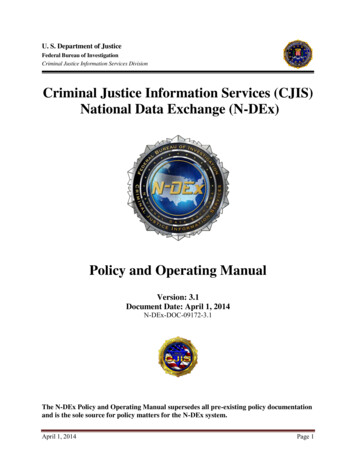

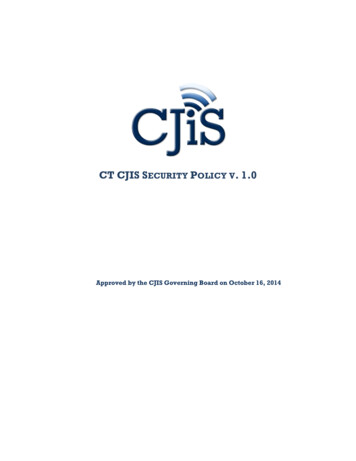
![Security Awareness Training 2015 Level I (002) [Read-Only]](/img/31/cogenttraininglevel1.jpg)
